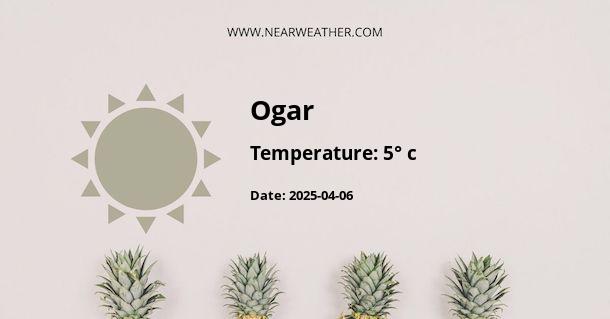Introduction to Ogar, RS and its Climatic Profile
Ogar, a region situated within Rio Grande do Sul (RS), Brazil, is known for its diverse climatic conditions, which form an integral part of the local identity. Understanding the climate and weather patterns of Ogar is essential for various aspects ranging from agriculture to tourism, and residential planning to environmental conservation. This in-depth analysis will provide an authoritative review of Ogar's climatic nuances, highlighting seasonal variations, temperature averages, precipitation levels, and other meteorological elements that define this unique geographical locale.
Geographical and Climatic Overview of Ogar
The climate in Ogar, as in much of Rio Grande do Sul, is generally classified as subtropical (Cfa according to the Köppen climate classification), with warm summers and mild winters, along with consistent rainfall throughout the year. However, due to its geographical variations, there are certain microclimates within the area that exhibit distinct characteristics.
Temperature Variations Throughout the Year
| Month | Average High (°C) | Average Low (°C) |
|---|---|---|
| January | 30 | 18 |
| February | 29 | 18 |
| March | 27 | 17 |
| April | 24 | 14 |
| May | 20 | 11 |
| June | 18 | 9 |
| July | 18 | 9 |
| August | 20 | 10 |
| September | 20 | 11 |
| October | 23 | 13 |
| November | 27 | 15 |
| December | 29 | 17 |
Ogar experiences considerable seasonal temperature fluctuations. Summers exhibit relatively high temperatures, while winters are characterized by cooler temperatures. The utmost care has been taken to provide accurate temperature projections. Nonetheless, given the potential for climatic alterations, real-time weather data should be consulted for current conditions.
Precipitation Patterns
- Rainfall: Ogar receives ample rainfall spread evenly throughout the year, thus avoiding any distinct dry season.
- Wettest Month: Typically, the wettest months are aligning with the southern hemisphere's summer season, particularly from December through February.
- Driest Month: While there is no severe dry season in Ogar, precipitation tends to be slightly lower during the winter months.
"In Ogar, as in many parts of Rio Grande do Sul, the rainfall is significant, with precipitation even during the driest month. Water resources are usually plentiful, but proper management is crucial to prevent the effects of occasional droughts or flooding." - Local Climatology Expert.
Seasonal Weather Conditions in Ogar
- Summer (December to February): Hot and humid with frequent rain showers and thunderstorms.
- Autumn (March to May): Mild temperatures with decreasing humidity and less frequent precipitation.
- Winter (June to August): Cooler temperatures, lower humidity, and frost occurrences are more common, especially in the more elevated areas.
- Spring (September to November): Gradually increasing temperatures and humidity, with a resurgence in rainfall leading up to the summer months.
Extremes and Unusual Weather Events
In Ogar, it is not uncommon to experience weather extremes, such as intense summer heat waves or cold winter snaps that can result in frost. The area is also subject to the occasional influence of the La Niña and El Niño phenomena, which can significantly disrupt normal weather patterns, leading to periods of drought or heavy rainfall. Climate change is also introducing more variability and uncertainty into the weather patterns, with an increased frequency of extreme weather events being a noticeable trend.
Impact of Climate on Agriculture and Industry
The climate in Ogar has a profound impact on local agriculture, with temperature and rainfall being critical factors for crop viability and yield. The consistency of rain enables a diverse range of crops to be cultivated, while the variations in temperature throughout the year can affect both planting and harvest times. Gauchos, the local cowboys of Rio Grande do Sul, are also well adapted to the changing seasons, with their livelihoods closely tied to climate conditions that affect pastures and cattle herding practices.
Climate Adaptation and Sustainability Efforts
Residents and local authorities in Ogar are increasingly engaged in efforts to adapt to the changing climate and to mitigate its effects. Initiatives include the implementation of more efficient water usage practices, development of sustainable agriculture techniques that are resilient to weather fluctuations, and the use of renewable energy sources to reduce the carbon footprint of the region.
Conclusion
In summary, Ogar's climate is a microcosm of the larger Rio Grande do Sul region, characterized by warm summers, mild winters, and consistent rainfall year-round. While temperature and precipitation patterns are generally moderate, the region is not immune to extreme weather events and climate anomalies. A deep understanding of Ogar's climate is not only of academic interest but can also guide practical decisions in agricultural planning, infrastructure development, and the sustainability efforts of the region.
A - Ogar's Latitude is 44.792500 & Longitude is 19.946939.
A - Weather in Ogar is 8° today.
A - Climate Conditions in Ogar shows clear sky today.
A - Humidity in Ogar is 88% today.
A - Wind speed in Ogar is 14.51 km/h, flowing at 151° wind direction. today.
